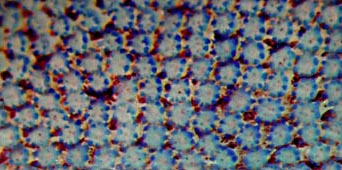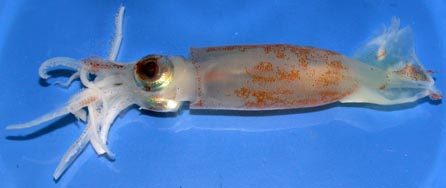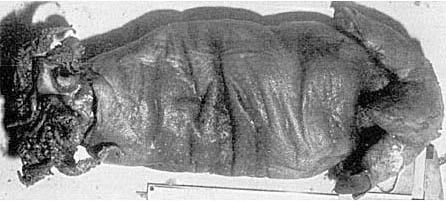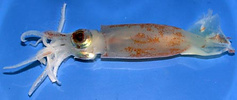Pholidoteuthis boschmai
Michael Vecchione and Richard E. YoungIntroduction
This is a large, fairly muscular squid, reaching 58 cm ML that occurs world-wide but little is known of its biology or ecology.
Diagnosis
A Pholidoteuthis ...
- with papillate tubercules.
Characteristics
- Arms
- Longest 30-60% of ML.
- Longest 30-60% of ML.
- Mantle
- Mantle with papillate tubercules.
 Click on an image to view larger version & data in a new window
Click on an image to view larger version & data in a new window
Figure. Ventral view of a portion of the mantle of P. boschmai. Papillae on the tubercules are stained lightly with methylene blue stain. Photograph by R. Young.
Scanning electron micrographs of the papillate tubercules can be seen here.
- Mantle with papillate tubercules.
- Gladius
- With primary (?) conus.
- With primary (?) conus.
- Fins
- Length 35-45% of ML.
Comments
Arm suckers have 10-15 sharp teeth on the distal half of the inner ring.
Nomenclature
Pfeffer (1912) established the genus Tetronychoteuthis based on Onychoteuthis dussumieri d'Orbigny, 1839. The latter, however, is a species of Onykia (=Moroteuthis) (Roper and Lu, 1989, Nesis and Nikitina, 1990). Nesis and Nikitina (1990) consider Onychoteuthis dussumieri and the generic name based on it (Tetronychoteuthis) as nomina dubia and that Pholidoteuthis is the valid name of the genus. Pfeffer (1912) described Tetronychoteuthis (=Pholidoteuthis) massayi from the north Atlantic (47°N, 15°W) although realizing that this species could represent a young stage of Tetronychoteuthis dussumierii (=Pholidoteuthis boschmai; see Nomenclature section under Pholidoteuthis). Nesis and Nikitina (1990), also, considered this a possibility. The primary character separating the two forms besides size is the shape and structure of the tubercules. These, however, change with ontogeny (Nesis and Nikitina, 1990). We consider Pholidoteuthis massayi to be the junior synonym of Pholidoteuthis boschmai.
Life History
The paralarva of P. boschmai has been tentatively recognized from waters off Hawaii via a process of elimination rather than by the more reliable method of tracing a size series to an identifiable juvenile. One of the characteristic features is the posterior position of the digestive gland (dotted circle) which is found in families with buccal connectives that attach to the ventral borders of arms IV. In this species the digestive gland is unusually far posterior. The scale bar is 1 mm.
Distribution
Type locality is the Flores Sea 05°58'S, 121°32'E. Distribution is circumglobal in subtropical to cold temperate waters (Nesis, 1982) but few specimens have been described.
References
Adam, W. 1950. Un cephalopode nouveau: Pholidoteuthis boschmai gen. Et sp. Nov. Koninklijke Nederlandse Akademie van Wetenschappen, 53: 1-8.
Clarke, M. R. 1980. Cephalopoda in the diet of sperm whales of the Southern Hemisphere and their bearing on sperm whale biology. Discovery Reports, 37: 1-324.
Nesis, K.N. and I.V. Nikitina. 1990. Revision of the squid family Lepidoteuthidae. Zool. Zhurnal, 69: 39-49.
Pfeffer, G. 1912. Die Cephalopoden der Plankton-Expedition. Ergebniss der Plankton-Expedition der Humboldt-Stiftung. 2: 1-815.
Roper, C.F.E. and C.C. Lu. 1989. Systematic status of Lepidoteuthis, Pholidoteuthis and Tetronychoteuthis (Cephalopoda: Oegopsida). Proc. Biol. Soc. Wash., 102: 805-807.
Title Illustrations

| Scientific Name | Pholidoteuthis boschmai |
|---|---|
| Location | R/V G. O. SARS, Mar-Eco cruise, central North Atlantic. |
| Size | ca. 7 cm ML |
| Copyright |
© 2004 Richard E. Young

|
About This Page

National Museum of Natural History, Washington, D. C. , USA
Richard E. Young

University of Hawaii, Honolulu, HI, USA
Page copyright © 1999 and Richard E. Young
- Content changed 10 December 2006
Citing this page:
Vecchione, Michael and Young, Richard E. 2006. Pholidoteuthis boschmai . Version 10 December 2006 (under construction). http://tolweb.org/Pholidoteuthis_boschmai/19854/2006.12.10 in The Tree of Life Web Project, http://tolweb.org/











 Go to quick links
Go to quick search
Go to navigation for this section of the ToL site
Go to detailed links for the ToL site
Go to quick links
Go to quick search
Go to navigation for this section of the ToL site
Go to detailed links for the ToL site